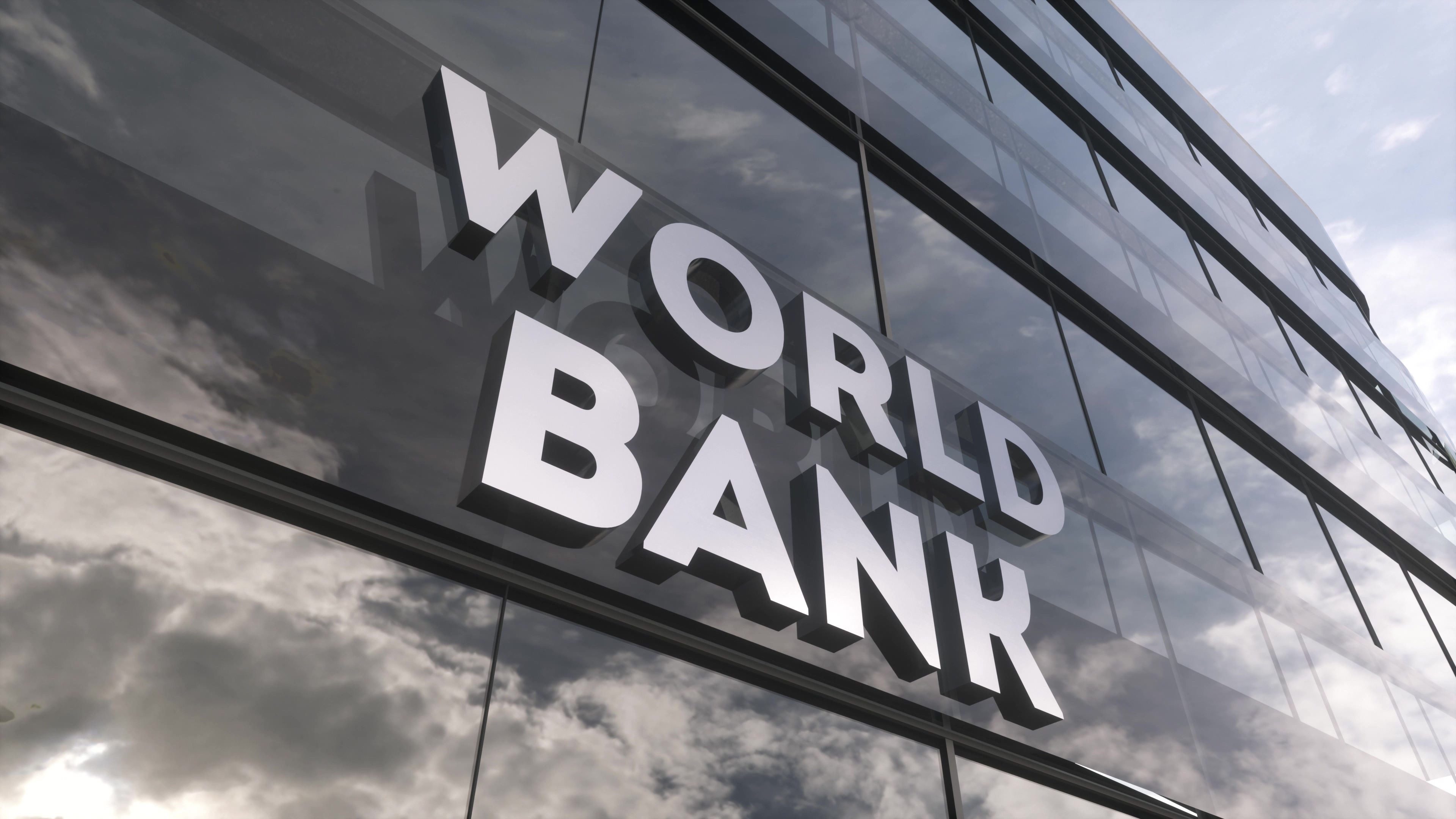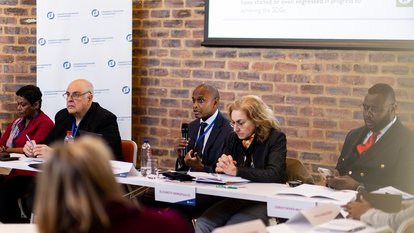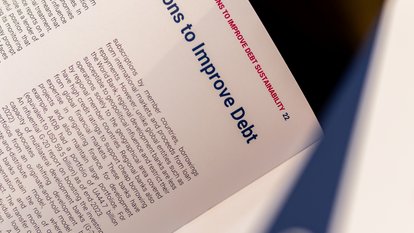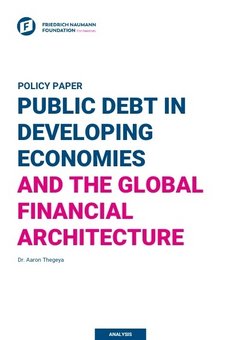G20
Reimagining global finance

World Bank on glass building. Mirrored sky and city modern facade.
© ShutterstockAs developing economies face a tightening vice of debt fragility and shrinking fiscal space, experts and policymakers gathered under the aegis of the Friedrich Naumann Foundation for Freedom to interrogate the global financial architecture’s role in sustaining—or stalling—economic resilience in the Global South.
At the centre of the discourse there is a sobering reality: 35 developing countries are now on the verge of default. Of these, nine are already in debt distress—all low- to middle-income economies—with 26 additional economies in Sub-Saharan Africa at high risk of distress. Alarmingly, many developing countries with high debt burdens now spend more on interest payments than on education and health, reflecting a dangerous reprioritisation of public spending at the expense of long-term development.
The cost of borrowing is rising, adding pressure to economies already struggling with limited fiscal space. While the volume of public debt held by low-income countries is marginal—less than 1% of global debt—the social and economic consequences are severe. In stark contrast, 71% of global public debt is held by high-income countries, underscoring a significant imbalance in the international financial system. The issue is not merely one of accumulation, but of how debt is structured, who holds it, and whether it enables or constrains development.
Despite contributing little to global debt totals, developing countries shoulder a disproportionately high developmental and human cost. As debt servicing obligations divert critical resources away from healthcare, education, and infrastructure, the knock-on effects are visible. From rising food insecurity in Ghana to stalled progress on the Sustainable Development Goals (SDGs), this is not just an economic crisis—it is a deeply social and political one.






A broken system?
Dr. Aaron Thegeya, author of the Foundation’s flagship policy paper, argues that global financial architecture is fundamentally flawed. “Debt fragility is not a series of isolated events,” he writes. “It is systemic and widespread, driven by structural inequities in how sovereign debt is originated, managed, and renegotiated.” Among the most critical flaws is the currency denomination of debt. Unlike high-income nations that borrow largely in their currencies, developing countries often carry debt in foreign currencies, primarily U.S. dollars, exposing them to exchange rate volatility and rising interest rates in the Global North.
Multilateral debt, while typically offered on concessional terms, is also inflexible. Institutions like the World Bank, concerned with maintaining AAA credit ratings, are often reluctant to restructure loans—even in the face of humanitarian crises. Consequently, governments in developing nations are forced to choose between fiscal responsibility and social unrest—as seen in Ghana’s widespread protests sparked by inflation, debt pressure, and austerity.
“Debt fragility is not a series of isolated events. It is systemic and widespread, driven by structural inequities in how sovereign debt is originated, managed, and renegotiated.”

History repeating
Debt distress in the developing world is not new. From the Latin American crisis in the 1980s to the Asian Financial Crisis in 1997, history shows that low interest rates, and rapid borrowing, when mixed with external shocks and political instability, create fertile ground for crisis. In the 2020s, this pattern continues—compounded by the COVID-19 pandemic, geopolitical upheaval, and a dramatic shift away from accommodative global monetary policy. Countries that had previously borrowed heavily for infrastructure, often under initiatives like China’s Belt and Road, are now struggling with rising repayments and limited growth.
Yet the tools for orderly debt restructuring remain inadequate. The Common Framework for Debt Treatments, launched in the wake of the COVID-19 pandemic, has made slow progress. Only four countries—Chad, Ethiopia, Ghana, and Zambia—have applied, and negotiations have been slow and politically fraught. The complexity is worsened by the greater diversity of creditors including China, now a major creditor outside of the Paris Club, thus making coordination across lenders more difficult.
Debt, politics, and the fragile middle
At the roundtable, experts agreed that economic shocks are inevitable, but responses can make the difference between recovery and collapse. Dr Roshan Perera highlighted the need for prompt and decisive action in debt management. “Swift responses are critical to safeguard national economies and avoid prolonged damage,” she stated, calling for improved public debt management frameworks and stronger fiscal planning.
Dr. Christopher Mugaga reinforced the deep political nature of debt in developing contexts. “You cannot separate debt from the political discussion,” he said, stressing that disciplined implementation of resolutions, particularly those affecting low-income populations, is essential to managing and mitigating debt crises.
Offering a national lens, Jordan Griffith commented on South Africa’s fiscal roadmap, raising concerns over whether the country is managing its debt risks effectively. He emphasised the critical need for alignment between central bank policy and fiscal expenditure and warned that a lack of transparency in budget management turns debt crises into political-economic flashpoints, eroding public trust and fueling unrest.
Global architecture, local consequences
Although developing economies hold only a small fraction of global debt, they are disproportionately affected by debt fragility. Institutions like the IMF and World Bank—who are senior creditors—often structure agreements in ways that prioritise their repayment over a borrowing country's long-term resilience. Ms Elizabeth Sidiropoulos drew attention to a key misconception: “Some of the instruments we’ve created in the last few years treat debt as if it's a liquidity problem when in many cases, it’s a solvency problem.” This misdiagnosis leads to inappropriate policy responses and perpetuates cycles of debt distress. Additionally, closed economies, those with limited trade and external engagement—are more vulnerable to unsustainable debt burdens. Without sufficient foreign exchange earnings, often generated through diversified exports, these countries struggle to repay external obligations and face mounting fiscal stress.
“Swift responses are critical to safeguard national economies and avoid prolonged damage.”

Fragile foundations and the path ahead
The debt crises of the 2020s follow a now-familiar sequence: ambitious borrowing, global shocks, crisis, and inadequate response. The rise of private and non-traditional lenders, including China, complicates the negotiation landscape. Traditional frameworks such as the Paris Club and the Common Framework are increasingly seen as outdated.
From the roundtable and Dr. Aaron Thegeya's analysis, several policy priorities emerged:
- State-Contingent Debt Instruments (SCDIs): These adjust repayment terms based on macroeconomic performance, reducing pressure during downturns.
- Regional Development Banks (e.g. the AfDB) adopt originate-and-distribute models that allow for project origination while transferring risk to private investors, ideally in local currencies.
- Greater transparency in public finance, including results-based financing, where loans are repaid based on verified development outcomes.
- Debt-for-climate swaps, enabling countries to reduce external debt while financing critical climate adaptation, a growing necessity in vulnerable regions.
Conclusion: A political and economic imperative
As debt servicing consumes an increasing share of national budgets, the human costs are mounting—rising poverty, hunger, food insecurity, and unrest. Public debt can be a driver of development, but only when managed through transparent, disciplined, and coordinated governance. The message from the roundtable was unequivocal: the current global financial architecture is not fit for purpose. Without urgent and comprehensive reform, millions in the Global South will remain trapped in a cycle of borrowing that yields little return. As fiscal pressures mount and citizens question the value of foreign debt, the crisis becomes not just economic, but political.
The way forward
Debt is not inherently harmful—it is a necessary tool for progress. But as Dr. Aaron Thegeya concludes, “It is not just about how much debt is taken on, but how it is structured, who holds it, and under what terms it can be adjusted in times of crisis.” The path forward requires more than new instruments; it demands structural reform, greater global equity, and political will. Both debtor and creditor nations must recognise their shared responsibility. Failing to act will entrench inequality, deepen instability, and place sustainable development ever further out of reach for the 688 million people living in low-income countries. As participants left the roundtable, one conclusion rang clear: debt distress is not a future threat, it is a current crisis. And the architecture that supports it must be rebuilt.


